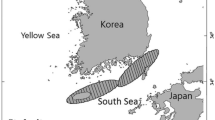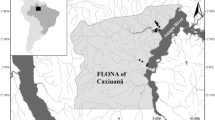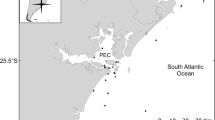Abstract
Growth and reproduction of the Japanese mantis shrimp, Oratosquilla oratoria, were investigated in the Tongyeong, Korea from July 2014 to August 2015. A total of 2,621 samples (1,380 females and 1,241 males) were collected during the study period. Females were observed more frequently than males. The mean body length (BL) was 128.5 ± 0.38 mm in females and 126.9 ± 0.42 mm in males. The mean body weight (BW) was 31.2 ± 0.28 g in females and 31.1 ± 0.32 g in males. There was a significant difference in the length-frequency distribution between females and males. The relationship between BL and BW was lnBW = 2.85 × lnBL - 10.43 for females and lnBW = 2.87 × lnBL -10.52 for males. The gonadosomatic index (GSI) varied on a monthly basis. The GSI reached a maximum in May and a minimum in November. The highest values of the GSI coincided with the spawning period of O. oratoria. Larger individuals of O. oratoria have their spawning season earlier than smaller ones. The size at sexual maturity of females was estimated as 96.5 mm. The Von Bertalanffy growth function parameters were BL∞ = 184.5 mm, K = 0.72 year−1, C = 0.36 and WP = 0.45 for females and BL∞ = 183.75 mm, K = 0.82 year−1, C = 0.38 and WP = 0.22 for males. The growth of males was slightly faster than females. The present study will help with the fisheries management of O. oratoria based on ecological parameters.
Similar content being viewed by others
References
Ahyong ST (2012) The marine fauna of New Zealand: mantis shrimps (Crustacea: Stomatopoda). Graphic Press & Packaging Ltd, Wellington, 112 p
Alcorlo P, Geiger W, Otero M (2008) Reproductive biology and life cycle of the invasive crayfish Procambarus clarkii (Crustacea: Decapoda) in diverse aquatic habitats of South-Western Spain: implications for population control. Fund Appl Limnol 173(3): 197–212
Caldwell RL (1991) Variation in reproductive behavior in stomatopod, Crustacean. In: Bauer RT, Martin JW (eds) Crustacean sexual biology. Columbia University Press, New York, pp 67–90
Chang YJ, Sun CL, Chen Y, Yeh SZ (2012) Modelling the growth of crustacean species. Rev Fish Biol Fisher 22(1): 157–187
Courtney AJ, Haddy JA, Campbell MJ, Roy DP, Tonks ML, Gaddes SW, Chilcott KE, O’Neill MF, Brown IW, McLennan M, Jebreen JE, van der Geest C, Rose C, Kistle S, Turnbull CT, Kyne PM, Bennett MB, Taylor J (2007) Bycatch weight, composition and preliminary estimates of the impact of bycatch reduction devices in Queensland’s trawl fishery. Fisheries Research and Development Corporation (FRDC), Brisbane, FRDC 2000/170 Final Report, 307 p
Deecaraman M, Subramoniam T (1983a) Mating and its effect on female reproductive physiology with special reference to the fate of male accessory sex gland secretion in the stomatopod squilla holoschista. Mar Biol 77(2): 161–170
Deecaraman M, Subramoniam T (1983b) Synchronous development of the ovary and the female accessory sex glands of a crustacean, Squilla holoschista. P Indian AS-Anim Sci 92(2): 179–184
Dittel AI (1991) Distribution, abundance, and sexual composition of stomatopods in the gulf of Nicoya, Costa rica. J Crustacean Biol 11(2): 269–276
El-Sherif SS, El-Khodary GM, Ghonim AZ (2012) Ovarian cycle and scanning electron micrographs of the spawned egg of female mantis shrimp Oratosquilla massavensis (Alexandria, Egypt). J Basic Appl Zool 65(2): 116–124
Gayanilo FC, Sparre P, Pauly D (2005) FAO-ICLARM stock assessment tools II: user’s guide. FAO, Rome, 168 p
Griffiths CL, Blaine MJ (1988) Distribution, population structure and biology of stomatopod Crustacea off the west coast of South Africa. S Afr J Marine Sci 7(1): 45–50
Hamano T, Matsuura S (1984) Egg laying and egg mass nursing behaviour in the Japanese mantis shrimp. Nippon Suisan Gakk 50:1969–1973
Hamano T, Matsuura S (1987) Egg size, duration of incubation, and larval development of the Japanese mantis shrimp in the laboratory. Nippon Suisan Gakk 53(1): 23–39
Hamano T, Morrissy NM, Matuura S (1987) Ecological information on Oratosquilla oratoria (Stomatopoda, Crustacea) with an attempt to estimate the annual settlement date from growth parameters. J Shimonoseki Univ Fish 36(9): 9–27
Hamano T, Morrissy NM (1992) Growth of Oratosquilla oratoria (de Haan, 1844) (Stomatopoda) in the sea of Suo-Nada, Japan. Crustaceana 63(3): 263–276
Hartnoll RG (1985) Growth, sexual maturity and reproductive output. In: Wenner AM (ed) Factors in adult growth. AA Balkema, Rotterdam, pp 101–128
Hartnoll RG (2001) Growth in crustacea - twenty years on. Hydrobiologia 449:111–122
James DB, Thirumilu P (1993) Population dynamics of Oratosquilla nepa in the trawling grounds off Madras. J Mar Biol Assoc India 35(1&2):135–140
Kim S, Hong S (2004) Reproductive biology of Palaemon gravieri (Decapoda: Caridea: Palaemonidae). J Crustacean Biol 24(1): 121–130
Kodama K, Oyama M, Lee JH, Akaba Y, Tajima Y, Shimizu T, Shiraishi H, Horiguchi T (2009a) Interannual variation in quantitative relationships among egg production and densities of larvae and juveniles of the Japanese mantis shrimp Oratosquilla oratoria in Tokyo Bay, Japan. Fisheries Sci 75(4): 875–886
Kodama K, Shimizu T, Yamakawa T, Aoki I (2004) Reproductive biology of the female Japanese mantis shrimp Oratosquilla oratoria (Stomatopoda) in relation to changes in the seasonal pattern of larval occurrence in Tokyo Bay, Japan. Fisheries Sci 70(5): 734–745
Kodama K, Shimizu T, Yamakawa T, Aoki I (2006) Changes in reproductive patterns in relation to decline in stock abundance of the Japanese mantis shrimp Oratosquilla oratoria in Tokyo Bay. Fisheries Sci 72(3): 568–577
Kodama K, Shiraishi H, Morita M, Horiquchi T (2009b) Reproductive biology of the Japanese mantis shrimp Oratosquilla oratoria (Crustacea Stomatopoda): annual cycle of gonadal development and copulation. Mar Biol Res 5(5): 415–426
Kodama K, Yamakawa T, Aoki I, Fukuda M, Shimizu T (2003) Multi-spawning under rearing condition, and reduction in size at maturity of the Japanese mantis shrimp Oratosquilla oratoria in Tokyo Bay. Bull Kanagawa Pref Fish Res Inst 8:77–79
Kubo I, Hori S, Kumemura M, Naganawa M, Soedjono J (1959) A biological study on a Japanese edible mantis-shrimp, Squilla oratoria (De Haan). J Tokyo Univ Fish 45(1): 1–25
Magalhães L, Felício M, Gaspar MB, Quintino V, Rodrigues AM (2014) Reproductive biology of Polybius henslowii Leach, 1820 (Decapoda, Polybiidae): a discard species from the northwestern Portuguese beam trawl fishery. Crustaceana 87(7): 784–800
Maynou F, Abell P, Sartor P (2004) A review of the fisheries biology of the mantis shrimp, Squilla mantis (L., 1758) (Stomatopoda, Squillidae) in the Mediterranean. Crustaceana 77(9): 1081–1099
Mili S, Bouriga N, Missaoui H, Jarboui O (2011) Morphometric, reproductive parameters and seasonal variations in fatty acid composition of the mantis shrimp Squilla mantis (Crustacea: Stomatopoda) in the Gulf of Gabes (Tunisia). J Life Sci 5(12): 1058–1071
Nakajima M, Kodama K, Horiguchi T, Tanaka Y, Shiraishi H (2010) Impacts of shifts in spawning seasonality and size at maturation on the population growth of mantis shrimp in Tokyo Bay. Mar Ecol-Prog Ser 418:179–188
Nakata N (1987) Growth of juveniles and adults of the Japanese mantis shrimp in Tokyo bay. B Jpn Soc Sci Fish 51:307–312
Lopes Veiga EC (1979) Fitting Von Bertalanffy growth curves in short-lived fish species. A new approach. Invest Pesq 43:179–181
Ohtomi J, Shimizu M (1988) Growth after recruitment completion and life-span of the Japanese mantis shrimp Oratosquilla oratoria in Tokyo Bay. Nippon Suisan Gakk 54(11): 1935–1940
Ohtomi J, Shimizu M (1989) Seasonal changes in sex ratio and condition factor of the Japanese mantis shrimp in Tokyo Bay. Suisanzoshoku 37(2): 143–146
Ohtomi J, Shimizu M (1994) Theoretical growth during the recruitment period and estimation of growth parameters of the Japanese mantis shrimp Oratosquilla oratoria in Tokyo bay. B Jpn Soc Sci Fish 58(1): 21–27
Ohtomi J, Shimizu M (1996) Market size category composition and stock assessment of the Japanese mantis shrimp Oratosquilla oratoria in Tokyo bay. B Jpn Soc Sci Fish 62(1): 32–39
Pauly D (1987) A review of the ELEFAN system for analysis of length-frequency data in fish and aquatic invertebrates. ICLARM Conf 13:7–34
Pauly D, Gaschüz G (1979) A simple method for fitting oscillating length growth data, with a program for pocket calculators. ICES CM 1979/6:24, 26 p
Pauly D, Ingles DJ, Neal R (1984) Application to shrimp stocks of objective methods for the estimation of growth, mortality and recruitment-related parameters from length-frequency data (ELEFAN I and ELEFAN II). In: Gulland JA, Rothschild BJ (eds) Penaeid shrimps-their biology and management. Blackwell Scientific Publications Ltd, Oxford, pp 220–234
Pauly D, Munro JL (1984) Once more on the comparison of growth in fish and invertebrates. Fishbyte 2:21
Ragonese S, Morara U, Canali E, Pagliarino E Bianchini ML (2012) Abundance and biological traits of the spottail mantis shrimp, Squilla mantis (L., 1758) (Crustacea: Stomatopoda), off the southern coast of Sicily. Cah Biol Mar 53:485–493
Rockett MD, Standard GW, Chittenden ME (1984) Bathymetric distribution, spawning periodicity, sex ratios, and size compositions of the mantis shrimp, Squilla empusa, in the northwestern Gulf of Mexico. Fish B-NOAA 82:418–426
Schram FR, Ahyoung ST, Patek SN, Green PA, Rosario MV, Bok MJ, Cronin TW, Mead Vetter KS, Caldwell RL, Scholtz G, Peller KD, Abell P (2013) Subclass hoplocarida calman 1904, order Stomatopoda Latreille, 1817. In: von Vaupel Klein JC, Charmantier-Daures M, Schram FR (eds) Treatise on zoologyanatomy, taxonomy, biology. Brill, Boston, pp 179–356
Torisawa M, Mitsuhashi M, Nagai Y (1998) Spawning season of the Japanese mantis shrimp Oratosquilla oratoria (de Haan) in Ishikari Bay, Hokkaido, Japan. Nippon Suisan Gakk 64(3): 453–461
Vila Y, Sobrino I, Paz Jiménez M (2013) Fishery and life history of spot-tail mantis shrimp, Squilla mantis (Crustacea: Stomatopoda), in the Gulf of Cadiz (eastern central Atlantic). Sci Mar 77(1): 137–148
Wardiatno Y, Mashar A (2010) Biological information on the mantis shrimp, Harpiosquilla raphidea (Fabricius 1798) (Stomatopoda, Crustacea) in Indonesia with a highlight of its reproductive aspects. J Trop Biol Conserv 7:63–73
Wortham-Neal JL (2002) Reproductive morphology and biology of male and female mantis shrimp (Stomatopoda: Squillidae). J Crustacean Biol 22(4): 728–741
Yamazaki M, Fuji A (1980) Reproductive cycle of the mantis shrimp, Squilla oratoria de Haan, in Matsu Bay. Hokkaido Daigaku Suisangaku-bu kenkyu iho. Bull Fac Fish Hokkaido Univ 31(2): 161–168
Yeon IJ, Park WG (2011) Development and distribution of the Japanese mantis shrimp Oratosquilla oratoria larvae in the northwestern water off Incheon. J Fish Mar Sci Educ 23(4): 763–771
Author information
Authors and Affiliations
Corresponding author
Rights and permissions
About this article
Cite this article
Kim, S., Kim, H., Bae, H. et al. Growth and reproduction of the Japanese mantis shrimp, Oratosquilla oratoria (De Haan 1844) in the coastal area of Tongyeong, Korea. Ocean Sci. J. 52, 257–265 (2017). https://doi.org/10.1007/s12601-017-0027-2
Received:
Revised:
Accepted:
Published:
Issue Date:
DOI: https://doi.org/10.1007/s12601-017-0027-2




